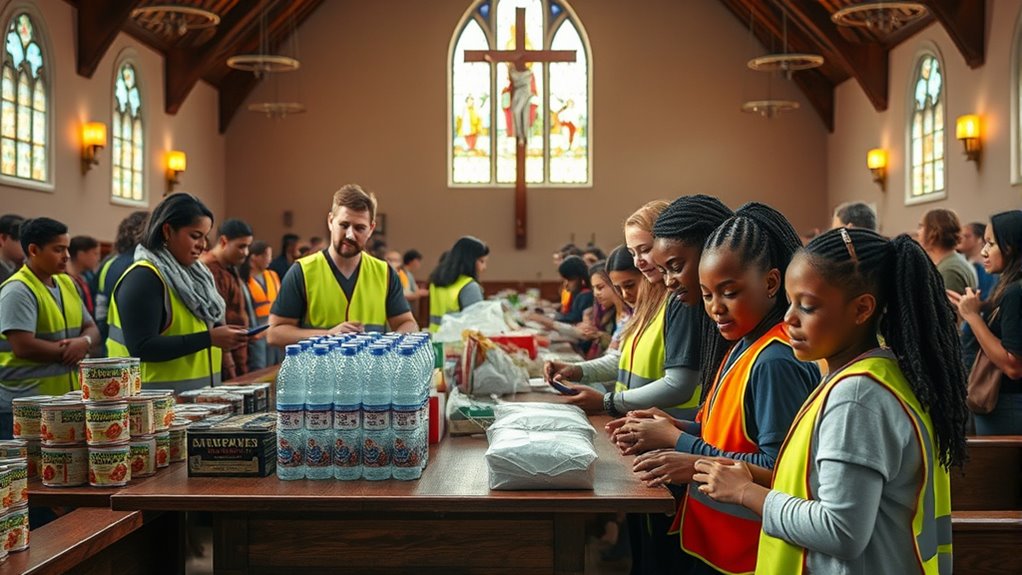As you explore disaster relief through a church, you’ll see how faith transforms aid through compassionate action rooted in Christ’s teachings. You can mobilize volunteers and resources quickly, offering both material help and spiritual comfort to survivors. By collaborating with local agencies and fostering community bonds, you deepen faith and resilience. To discover how your church can lead in these efforts and make a lasting impact, continue exploring the essential role of faith-based emergency response.
Key Takeaways
- Church-led disaster relief embodies Christ’s compassion through practical aid and spiritual support, demonstrating faith in action.
- Mobilizing volunteers and resources quickly ensures effective response and long-term recovery for affected communities.
- Providing emotional and spiritual care helps survivors find comfort, hope, and resilience amid chaos.
- Collaboration with local, state, and global agencies enhances resource sharing and coordinated efforts.
- Disaster relief efforts serve as a powerful testimony of faith, fostering spiritual growth and strengthening community bonds.
The Role of Faith-Based Organizations in Emergency Response
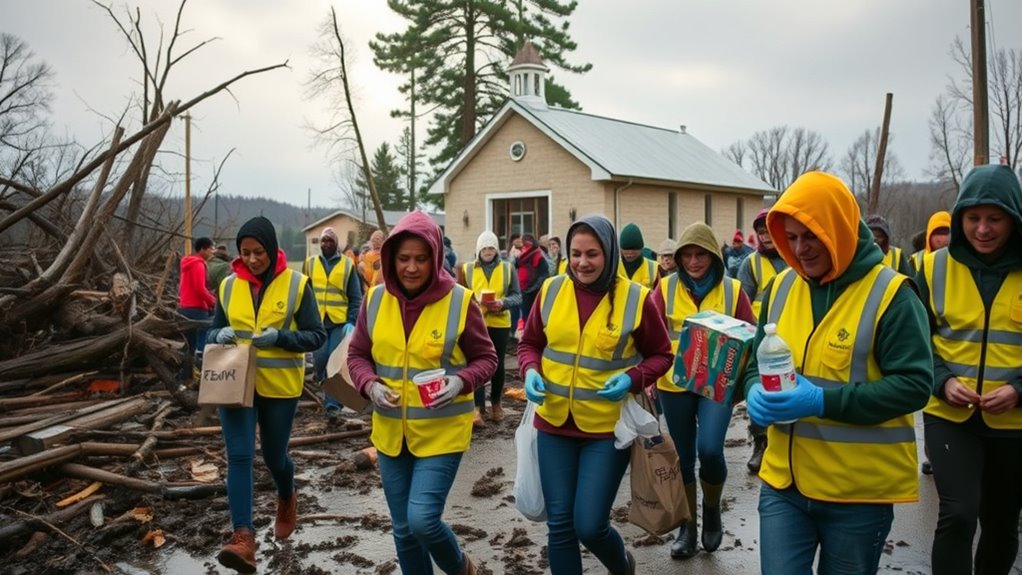
Have you ever wondered how faith-based organizations step up during emergencies? These groups draw on theological reflections to inspire action and guide their response strategies. They often mobilize community members through faith based fundraising, which provides essential resources for disaster relief efforts. By integrating spiritual principles, they foster hope and resilience among affected populations. Their work extends beyond immediate aid, offering emotional and spiritual support rooted in their beliefs. This commitment helps build trust and encourages ongoing community engagement. Faith-based organizations see disaster response as a calling, turning their faith into tangible assistance. Their ability to rally resources, both spiritual and material, makes them crucial players in emergency response, demonstrating how faith can drive meaningful and lasting relief efforts.
Mobilizing Volunteers and Resources for Immediate Assistance
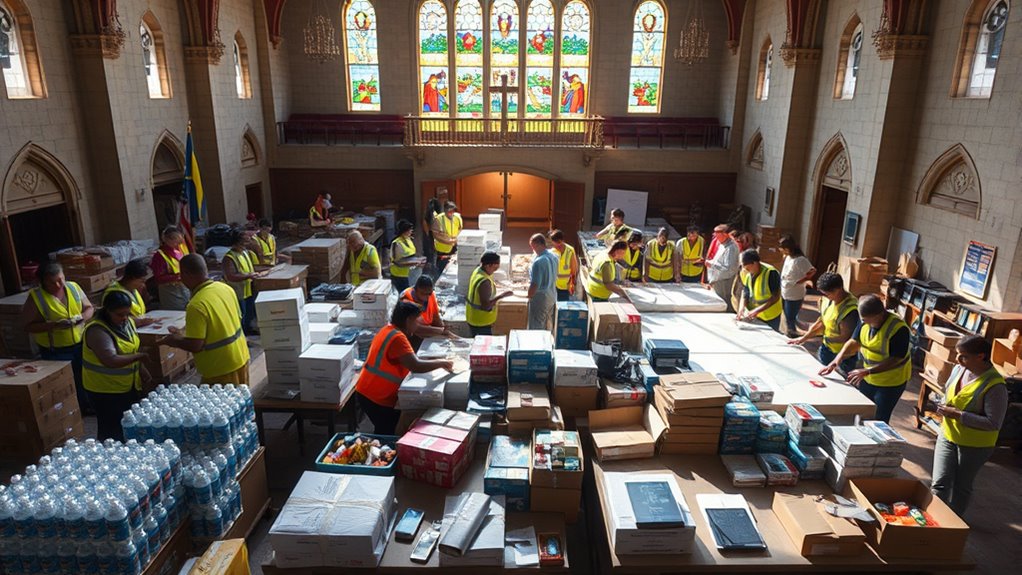
When disaster strikes, faith-based organizations quickly mobilize volunteers and resources to provide immediate assistance. Effective volunteer coordination ensures that help reaches the right locations efficiently. Leaders assign roles, communicate clearly, and keep volunteers motivated during chaotic times. Simultaneously, resource management becomes critical; you assess available supplies, allocate them strategically, and monitor ongoing needs. Churches often set up command centers to coordinate efforts and prevent duplication. Your organization’s ability to swiftly organize volunteers and manage resources directly impacts the speed and effectiveness of relief efforts. With proper planning, you guarantee that food, water, medical supplies, and manpower are directed where they’re needed most. This rapid response builds trust and lays a foundation for recovery, demonstrating your commitment to the community in its darkest hours.
Providing Spiritual and Emotional Support to Disaster Survivors
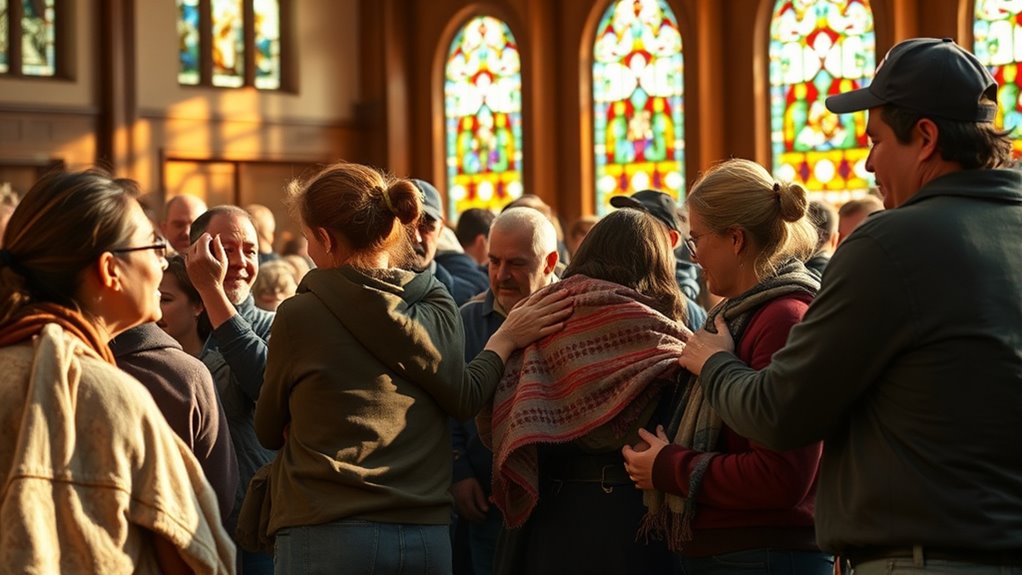
As a church, you can offer comfort and prayer to help survivors feel less alone in their pain. Facilitating emotional healing involves listening and providing a safe space for survivors to express their feelings. Your support can be a crucial step in helping them begin to recover emotionally.
Offering Comfort and Prayer
Offering comfort and prayer provides essential emotional and spiritual support to disaster survivors, helping them feel less alone amid chaos. You can organize prayer chains, allowing community members to pray continuously for those affected. These chains offer a sense of unity and hope, reminding survivors they’re not forgotten. Comfort ministries also play a crucial role by providing empathetic listening and spiritual reassurance, giving survivors a safe space to express their feelings. When you actively pray with or for those impacted, you help restore their sense of peace and trust. Your words and prayers serve as a tangible reminder of faith and community care, offering solace in difficult moments. Through these efforts, you demonstrate that compassion and prayer are powerful tools in healing emotional wounds.
Facilitating Emotional Healing
Facilitating emotional healing is essential in helping disaster survivors regain a sense of stability and hope. Your support through faith healing and emotional counseling can make a profound difference. You can offer a safe space where survivors feel heard and understood, helping them process their grief. Remember, spiritual guidance often provides comfort and strength during times of despair. Engaging in active listening and compassionate presence reassures survivors they are not alone. Your efforts can restore trust and foster resilience.
- Provide a listening ear that validates their pain
- Lead faith healing sessions to renew hope
- Offer emotional counseling tailored to individual needs
- Encourage community connections to rebuild trust and support
Collaborating With Government Agencies and Other Entities
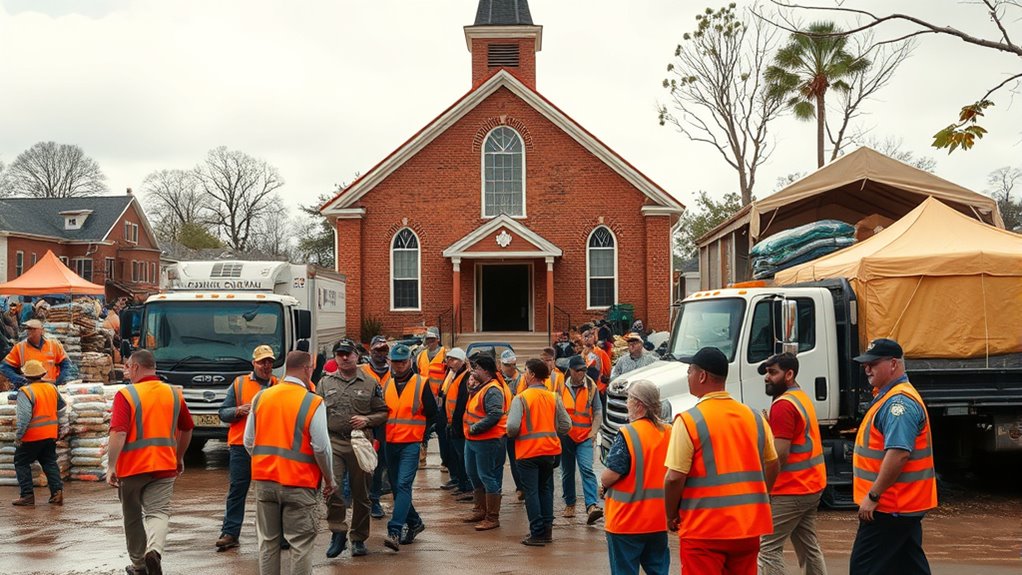
Collaborating with government agencies and other organizations is essential for effective disaster relief efforts. Your role involves building strong relationships to enhance interagency coordination, ensuring resources and efforts are aligned. By working closely with local, state, and federal agencies, you can facilitate smoother operations and avoid duplication. Additionally, engaging in policy advocacy helps your church influence disaster response regulations and community resilience strategies. Your active participation can lead to better-informed decisions and more effective resource allocation. Remember, your involvement amplifies the collective impact, making relief efforts more efficient and impactful. Clear communication, mutual respect, and shared goals are crucial. Through collaboration, your church becomes a fundamental part of a unified response, ultimately saving lives and supporting recovery.
Distributing Supplies and Essential Goods Effectively
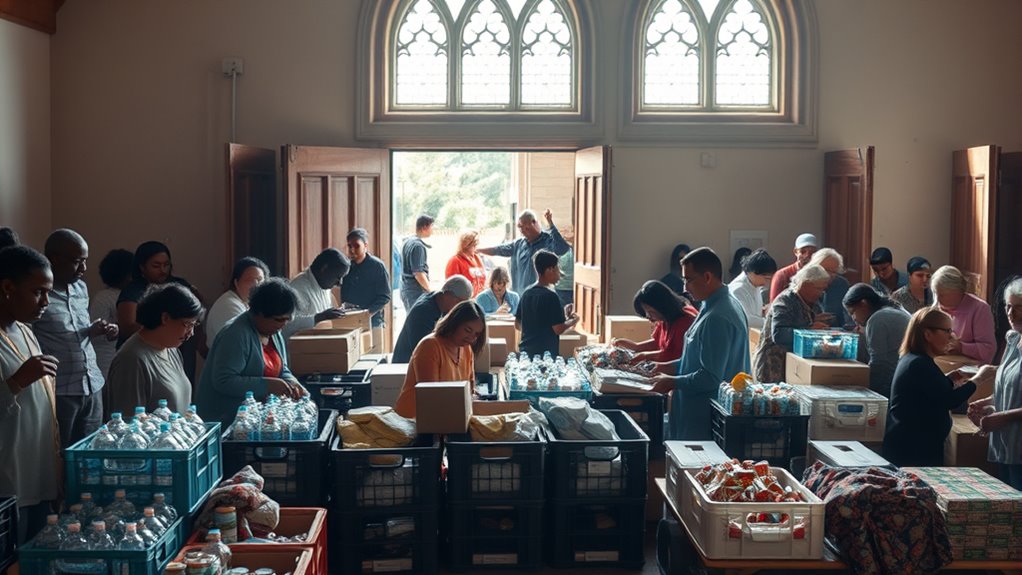
Effective distribution of supplies and essential goods is crucial to ensuring that relief reaches those who need it most without delay or confusion. You must organize food distribution carefully, prioritizing vulnerable populations and maintaining fairness. Equally important is delivering medical supplies swiftly, so healthcare providers can treat the injured and prevent disease. To do this, establish clear distribution points and coordinate with local partners to avoid chaos. Remember, a well-planned effort can save lives and restore hope.
Organize fair, swift supply distribution to save lives and restore hope amid chaos.
- You see their eyes light up with relief when they receive food and medical supplies.
- You hear stories of gratitude from families who felt forgotten.
- You witness the rebuilding of trust in your community.
- You feel the weight of your impact in every smile and grateful gesture.
Long-Term Recovery and Community Resilience Building
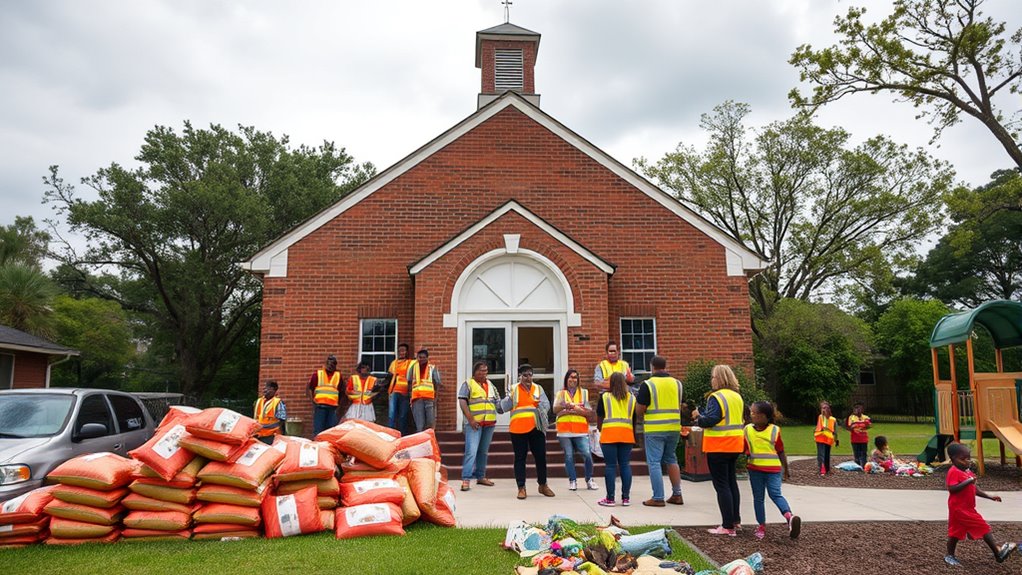
Long-term recovery goes beyond rebuilding structures; it involves strengthening the community’s resilience so they can better withstand future challenges. As a church, you play a crucial role in fostering this resilience through faith-based education that emphasizes hope, unity, and practical skills like disaster preparedness. By offering ongoing training and resources, you empower community members to respond confidently to future emergencies. Building resilience also means creating networks of trust and cooperation that persist beyond immediate relief efforts. Your involvement helps instill a mindset of proactive planning, ensuring the community is better equipped to recover quickly from setbacks. Long-term recovery is about more than fixing physical damage—it’s about cultivating a resilient, prepared community rooted in faith and shared responsibility.
Challenges and Opportunities in Church-Led Disaster Relief
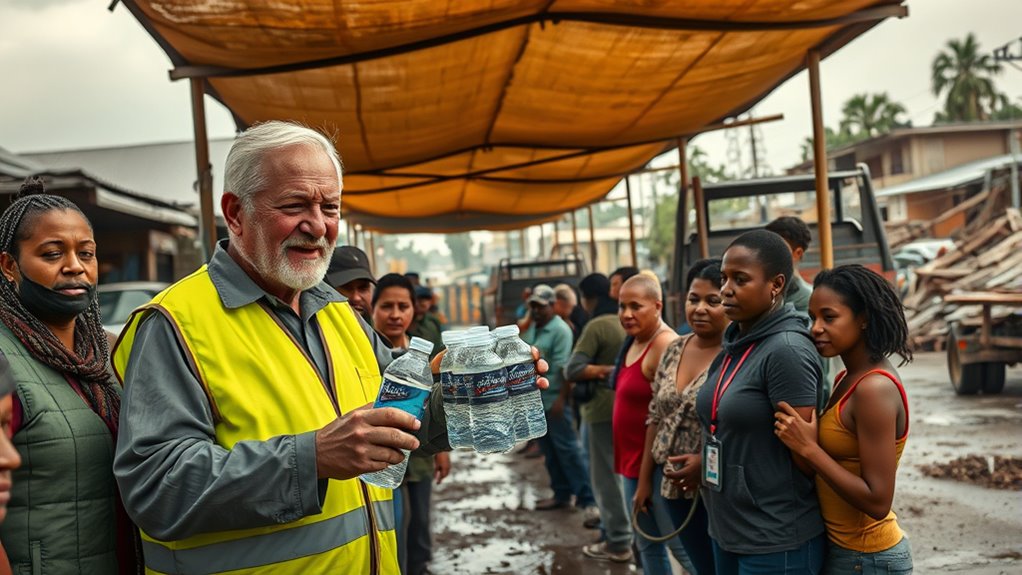
While church-led disaster relief offers significant opportunities to serve vulnerable communities, it also presents notable challenges that must be addressed. Faith-based advocacy can sometimes lead to misunderstandings or resistance from those of different beliefs, risking alienation. Theological reflection is essential to ensure that aid remains compassionate and culturally sensitive, but it can slow decision-making. Resource limitations and volunteer burnout threaten sustainability, and maneuvering complex bureaucracies can hinder swift responses. However, these challenges also open opportunities to deepen faith and community bonds. By engaging in honest faith-based advocacy, your church can foster trust and resilience. Embracing these obstacles as part of the spiritual journey encourages growth, unity, and a more profound commitment to embody Christ’s love in disaster relief efforts.
Frequently Asked Questions
How Do Churches Fund Disaster Relief Efforts Sustainably?
You can fund disaster relief efforts sustainably through diverse fundraising strategies like online campaigns, grants, and partnerships with local businesses. Engaging your community with volunteer recruitment strengthens support and encourages ongoing donations. Regular updates on relief progress inspire continued giving, while hosting events fosters a sense of shared purpose. By combining these approaches, you guarantee your efforts remain steady, impactful, and capable of meeting urgent needs over time.
What Training Do Church Volunteers Receive for Disaster Response?
Did you know that proper volunteer preparedness can improve disaster response outcomes by up to 50%? When you receive training, you’re taught essential disaster response protocols that ensure safety and efficiency. This training typically covers emergency procedures, communication skills, and first aid. By understanding these protocols, you’re better equipped to assist effectively, making a real difference during crises. Your preparedness directly impacts the success of relief efforts and community recovery.
How Do Churches Measure the Impact of Their Relief Work?
You measure the impact of your relief work by evaluating community engagement and spiritual impact. You gather feedback through surveys, interviews, and community meetings to see how your efforts meet needs and foster trust. Tracking volunteer participation and long-term recovery progress helps evaluate effectiveness. By focusing on these areas, you guarantee your work genuinely supports the community’s well-being and deepens spiritual connections, demonstrating meaningful, lasting change.
What Are Legal Considerations for Churches Providing Aid?
When providing aid, you need to consider legal liabilities and ensure proper insurance coverage. You might face lawsuits if someone gets injured or if aid causes unintended harm. To protect yourself, verify that your insurance covers disaster work and follow local laws and regulations. Keep detailed records of your activities, volunteers, and donations. Consulting legal experts can help you navigate liability issues and ensure your aid efforts stay compliant and protected.
How Do Churches Coordinate With Secular Emergency Organizations?
You should prioritize faith-based collaboration and community outreach by establishing clear communication channels with secular emergency organizations. This helps guarantee your efforts align with their protocols and avoid duplication. By working together, you can share resources, expertise, and information, making aid more effective. Building trust and understanding between faith-based groups and secular agencies enhances coordination, ultimately providing more all-encompassing support to those affected by crises.
Conclusion
Think of the church as a sturdy anchor amid a storm, holding steady as chaos swirls around it. Your faith and actions become the guiding light, helping others find their way to safety and hope. Together, you can turn the tempest into a path of renewal, building stronger communities that weather any storm. When you step up, you become part of a lasting legacy—resilience rooted in compassion and unwavering support.

